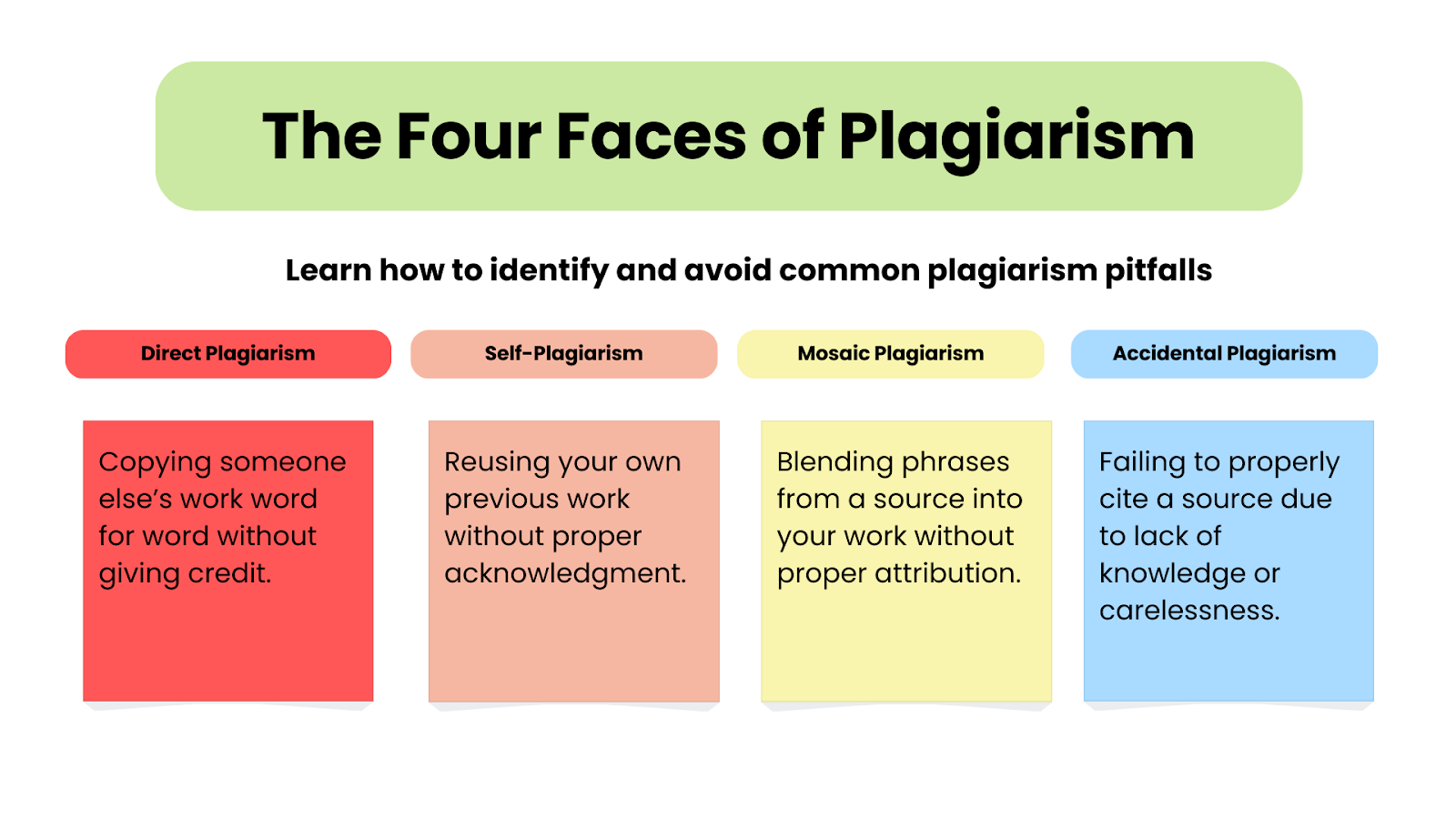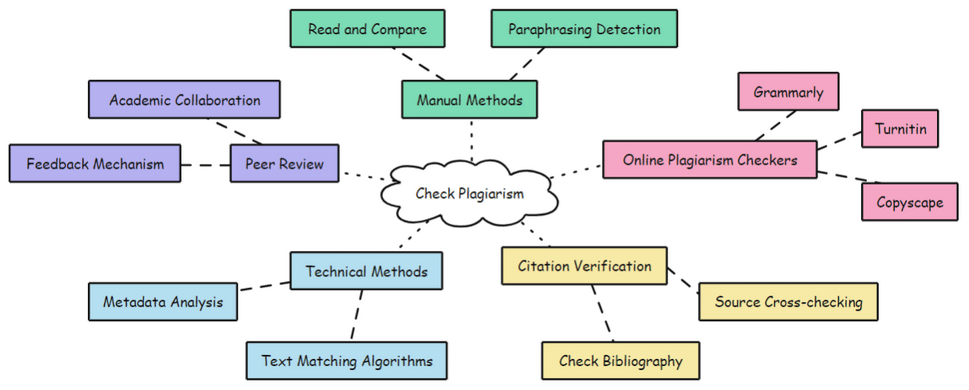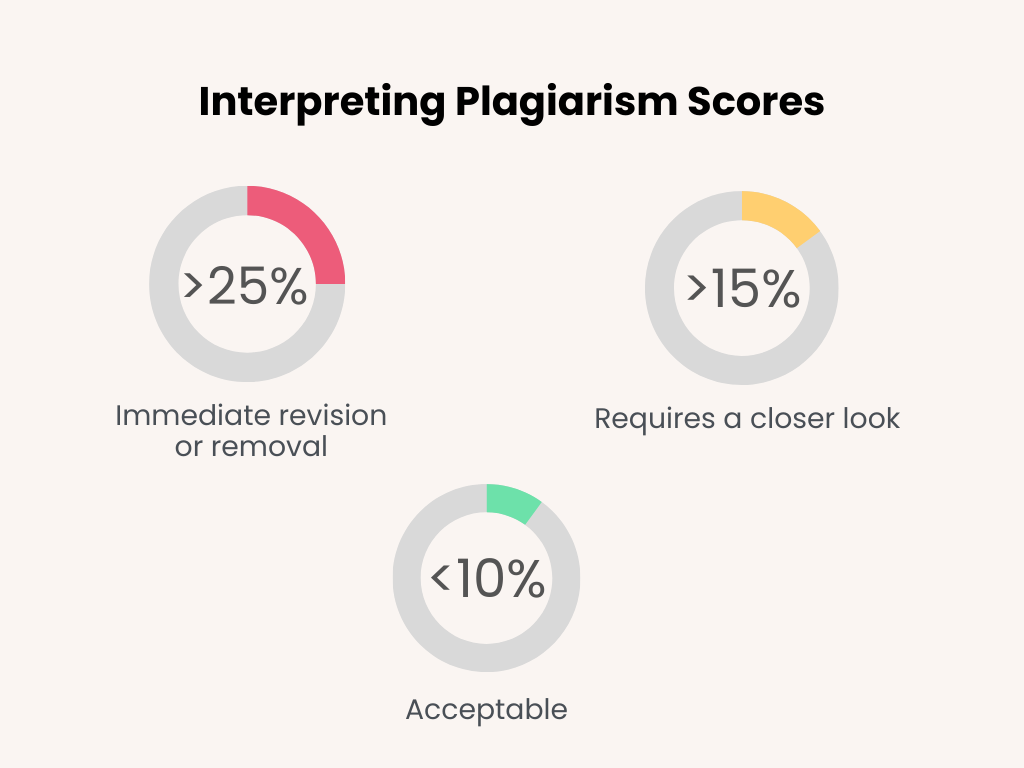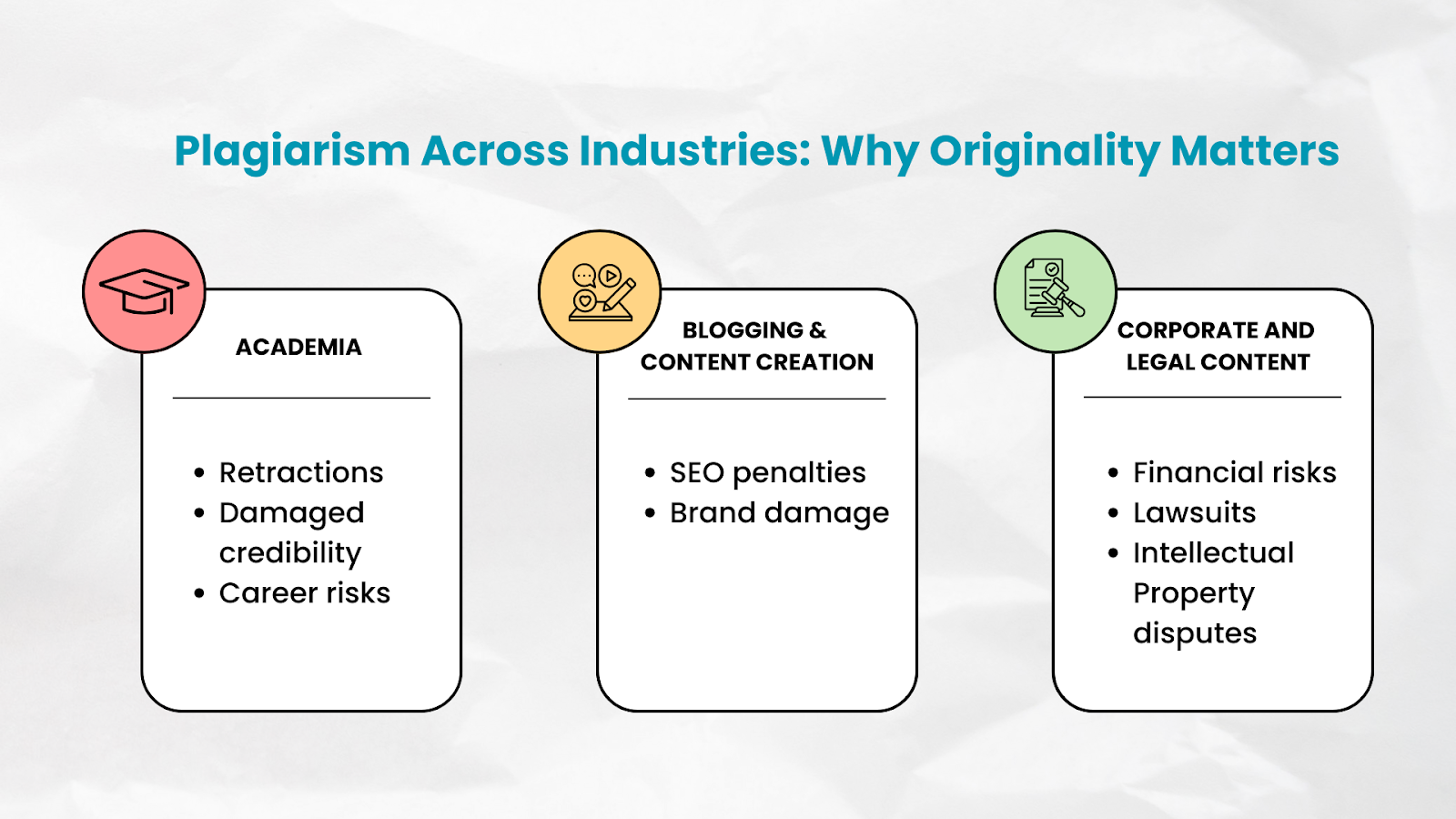Imagine spending countless hours crafting an article, only to discover that someone else has copied it without acknowledgement. This scenario is increasingly common in today’s digital age, where information is easily accessible and, unfortunately, easily misappropriated.
According to studies, 58% of high school students admitted to plagiarism, highlighting the prevalence of this issue from an early age.
Plagiarism isn’t confined to academia; it permeates professional sectors as well. In the corporate world, the repercussions can be severe, including job loss and legal action.
Moreover, with the rise of AI-generated content, detecting and preventing plagiarism has become more complex, necessitating advanced detection tools.
Let’s try to resolve the issue of plagiarism, exploring its various forms, the consequences across different industries, and the strategies to detect and prevent it. Understanding plagiarism is crucial in maintaining integrity and credibility in your work. Read on to equip yourself with the knowledge to handle the challenges of originality in the digital era.
What is Plagiarism and What are the Consequences of Plagiarism?
Plagiarism is the act of using someone else’s work or ideas without giving proper credit. It is a violation of intellectual property rights and is considered unethical. Plagiarism undermines originality and can occur intentionally or accidentally.
The consequences of plagiarism can be serious. In academics, it can result in failing grades, suspension, or expulsion. In business, it damages professional reputations and leads to legal disputes. Publishers face a loss of trust and credibility when plagiarism occurs. These outcomes show why accountability and originality are essential.
Originality builds trust and credibility. It respects intellectual property and acknowledges contributions. Unique work demonstrates professionalism and fosters engagement. In academics, business, and publishing, originality is vital to ethical practices and long-term success.

How Many Types of Plagiarism are There
Plagiarism comes in various forms. Here are the common types of plagiarism with examples:
- Direct Plagiarism: Copying another person’s work word for word without attribution.
Example: Submitting a copied essay from a website as your own. - Self-Plagiarism: Reusing your own previous work without proper acknowledgement.
Example: Using parts of an old research paper in a new project without citing it. - Mosaic Plagiarism: Blending phrases from a source into your writing without quoting or attributing.
Example: Paraphrasing sentences from an article but keeping the structure and phrasing too close to the original. - Accidental Plagiarism: Failing to properly cite a source due to lack of knowledge or carelessness.
Example: Forgetting to credit a book when using its ideas in your writing.
How to Check for Plagiarism?
Ensuring the originality of content is a critical step in maintaining credibility. Plagiarism checking can be done through manual efforts or with the help of specialized tools. Here’s a detailed guide to checking plagiarism step by step.
Manual Methods
Manual checking involves reviewing the content yourself to identify signs of plagiarism. While time-consuming, it can be effective in some cases.
- Reading and Cross-Referencing: Manually review the content to detect inconsistencies in tone, style, or vocabulary. For example, sudden changes in writing quality or phrasing might indicate copied sections.
Action Step: Compare such sections with other known sources to confirm originality.
- Using Search Engines: Copy and paste small chunks of text into search engines to find potential matches. This method works well for identifying direct duplication.
Action Step: Enclose the text in quotation marks during the search for more precise results.
Challenges of Manual Checking
- Detecting subtle forms of plagiarism, like paraphrasing, can be difficult.
- Large documents make manual efforts inefficient and prone to errors.
- It is impossible to compare content against extensive databases of published material.

Using Online Plagiarism Checkers
Plagiarism checkers are software solutions designed to scan text for originality. These tools cater to specific needs depending on the type of work being reviewed.
- General Plagiarism Checkers: These tools are ideal for a wide range of uses, from academic papers to blog posts. They scan online databases and websites to identify copied or similar text.
- Academic Plagiarism Checkers: Built for schools, universities, and researchers, these tools specialize in scanning published journals, books, and dissertations. They often integrate citation guidelines to help users identify improperly cited material.
- Content Plagiarism Checkers for Writers: Writers and content creators use these tools to ensure their work is free of unintentional duplication. These tools prioritize web content databases to detect potential overlaps.
- Enterprise Plagiarism Checkers: Businesses use tools to monitor legal documents, reports, and training materials. These tools often feature advanced algorithms to detect nuanced forms of plagiarism.

What is an Acceptable Amount of Plagiarism
Plagiarism checkers often provide reports with percentages and flagged content. Interpreting these results is crucial for identifying the areas that need attention.
How to Interpret Results?
- Low Scores: A score below 10% is generally acceptable for most types of content. It indicates minor overlaps, such as common phrases or unavoidable terminology.
- Moderate Scores: Scores between 10% and 25% require a closer look. Check if flagged sections are properly cited or if paraphrasing is too close to the source.
- High Scores: Anything above 25% is a cause for concern and indicates potential plagiarism. Immediate revision or removal of flagged sections is necessary.
When to Edit?
Identifying plagiarism is just the first step. Here’s how to handle it:
- Review flagged sections and verify sources.
- Correct citations for improperly referenced material.
- Paraphrase content where overlaps occur but avoid replicating the original structure.
- Remove copied sections and replace them with original ideas or insights.
Plagiarism in Specific Industries
Plagiarism affects different industries in unique ways, with varying consequences depending on the type of work involved. Understanding how plagiarism impacts these fields highlights the importance of maintaining originality and ethical practices.

Academia
Originality is the cornerstone of academic research. Plagiarism in this domain undermines academic integrity and the credibility of research work. Universities and research institutions often uphold strict anti-plagiarism policies to maintain their reputations.
- Importance of Originality in Research: Plagiarism disrupts the pursuit of knowledge by presenting copied ideas as new discoveries. It diminishes the value of authentic research and compromises the trust placed in academic publications. In severe cases, plagiarism in research can lead to the retraction of papers, loss of funding, and damage to academic careers.
- Common Scenarios: Accidental plagiarism is a frequent issue in academia. It occurs when students or researchers fail to properly cite sources or unintentionally paraphrase ideas without acknowledgement. Misattributed references and missing citations in dissertations or papers are common examples. Addressing these scenarios requires rigorous adherence to citation guidelines like APA, MLA, or Chicago styles.
Blogging and Content Creation
In the world of digital content, plagiarism has direct consequences on visibility, traffic, and brand reputation. Original content is a key factor in improving search engine rankings, making plagiarism a critical issue for bloggers and content creators.
- Duplicate Content Issues: Plagiarism in blog posts or articles can lead to duplicate content penalties from search engines like Google. These penalties reduce search rankings and organic traffic, severely affecting a website’s visibility. Beyond SEO, plagiarized content damages the trust of readers and followers, leading to long-term harm to a brand’s reputation.
Corporate and Legal Content
Plagiarism in professional settings, such as corporate reports and legal documents, carries significant risks. Unlike academic or creative plagiarism, the stakes here often involve financial or legal consequences.
- Plagiarism in Reports and Legal Documents: Duplicate content in internal reports or official communications can lead to misinformation and loss of credibility within an organization. In legal documents, plagiarism can result in lawsuits, intellectual property disputes, and violations of copyright laws. Corporations and law firms need to ensure their work is original and properly sourced to maintain compliance and professionalism.
Best Ways to Avoid Plagiarism
Avoiding plagiarism requires a proactive approach that combines good writing practices, proper citation, and the wise use of tools. When working with sources a writer can avoid plagiarism by:
Paraphrasing Effectively
Paraphrasing is a valuable skill for rewriting content without losing its original meaning. However, it must be done thoughtfully to avoid unintended duplication.
Paraphrasing involves expressing the ideas from a source in your own words while retaining the original meaning. It is an alternative to directly quoting or copying, but it still requires proper attribution.
Close paraphrasing, where only a few words are changed or rearranged, is one of the most common errors. This approach often results in content that is too similar to the original and may still be flagged as plagiarism. Failing to cite the original source is another major mistake.
Tips for Effective Paraphrasing
- Read the original content thoroughly to fully understand its meaning.
- Rewrite the ideas in your own style, focusing on delivering the message differently.
- Avoid looking at the source while paraphrasing to ensure originality.
- Cross-check your paraphrased content against the original to ensure it doesn’t resemble the phrasing too closely.
- Always cite the source, even when paraphrasing.
Citing Sources Properly
Proper citation is critical to acknowledging the original creators of ideas, whether you use direct quotes or paraphrased material.
Each field uses specific citation styles, such as:
- APA: Often used in social sciences, it emphasizes the author and publication year.
- MLA: Common in humanities, it focuses on the author and page number.
- Chicago: Frequently used in history and publishing, it supports footnotes and endnotes for referencing.
Tools for Easy Citation
Citation tools simplify referencing by generating properly formatted citations for books, articles, and websites. Popular tools include:
- Zotero: An open-source tool that helps collect, organize, and cite research materials.
- Citation Machine: A user-friendly platform that creates citations in multiple styles.
- Mendeley: Useful for managing research papers and creating bibliographies.
Using AI Tools Wisely
AI-generated content is becoming a common practice for creating drafts, but it requires careful review to avoid unintended plagiarism.
AI tools can produce coherent content quickly, but they often pull phrases or ideas from various sources. Without proper validation, this can lead to unintentional duplication. Relying entirely on AI may result in work that lacks originality or fails to address specific needs.
Ensuring Originality in AI Outputs
- Always review AI-generated content manually to identify potential overlaps with existing material.
- Run the content through a plagiarism checker to ensure it is free from duplication.
- Use AI tools as a starting point, but revise and add your unique perspective to the final draft.
- Cite any sources referenced in the AI-generated content to maintain ethical standards.
Emerging Trends in Plagiarism Detection
Artificial Intelligence (AI) is revolutionizing plagiarism detection, making the process faster and more accurate than ever before. By using advanced algorithms and machine learning, AI tools are now capable of identifying even subtle forms of duplication.
- Advanced Text Analysis: AI-powered tools use Natural Language Processing (NLP) to analyze text contextually, detecting paraphrased content and altered sentence structures.
- Real-Time Detection: Some tools provide real-time plagiarism checks during the writing process, helping users correct issues instantly.
- Extensive Database Access: AI systems cross-reference text against billions of web pages, academic papers, and proprietary databases in seconds.
- Pattern Recognition: AI detects subtle patterns in text, identifying similarities beyond direct matches, such as rephrased ideas or stylistic changes.
- Multilingual Capabilities: AI tools can now check for plagiarism across multiple languages, broadening their scope for global use.
- Multimedia Detection: Emerging AI technologies are being developed to analyze and detect plagiarism in multimedia content like images, videos, and audio.
- AI-Generated Content Detection: Specialized AI tools can identify text generated by other AI models, addressing challenges with originality in AI-created works.
- Future Ethical Considerations: AI advancements are pushing for tools that balance robust detection with respect for user privacy and proper attribution.
Conclusion
Maintaining originality is not just a best practice, it’s a necessity. Plagiarism undermines credibility and can lead to serious legal and ethical consequences. By implementing effective strategies such as thorough paraphrasing, proper citation, and the judicious use of AI tools, you can ensure the integrity of your work. Remember, originality fosters trust and sets you apart in a crowded digital space.